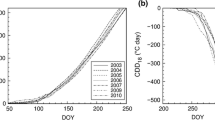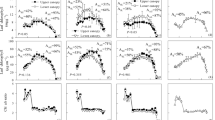Abstract
Seasonal changes in leaf demography and gas exchange physiology in the tall evergreen tussock grass Stipa tenacissima, one of the few dominant plant species in the driest vegetation of Europe, were monitored over a period of two years at a field site in semi-arid south-eastern Spain. Three age-classes of leaves – young, mature and senescent – were distinguished in the green canopy. Production of new leaves and extension growth of older leaves occurred exclusively from October–November to May–June. The rate of extension was significantly correlated with gravimetric soil water content. Leaf growth ceased after gravimetric soil water content fell below 0.015 g g−1 at the beginning of the dry season which corresponded to pre-dawn leaf water potentials of -3.0 MPa. Leaf senescence and desiccation reduced green leaf area by 43–49% during the dry season. Diurnal changes in the net photosynthetic rate of all three cohorts of leaves were bimodal with an early morning maximum, a pronounced midday depression and a small recovery late in the afternoon. Maximum photosynthetic rates of 10–16 μmol CO2 m−2 s−1 were attained from November 1993 to early May 1994 in young and mature leaves. Photosynthetic rate declined strongly during the dry season and was at or below compensation in September 1994. Gas exchange variables of young and mature leaves were not significantly different, but photosynthetic rate and diffusive conductance to water vapour of senescing leaves were significantly lower than in the two younger cohorts. Leaf nitrogen content of mature leaves varied seasonally between 2.9 and 5.2 g m−2 (based on projected area of folded leaves), but was poorly correlated with maxima of the photosynthetic rate. There was a stronger linear relationship between the daily maxima of leaf conductance and pre-dawn leaf water potential than with atmospheric water vapour saturation deficit. Seasonal and between-year variation in daily carbon assimilation were caused mainly by differences in climatic conditions and canopy size whereas the effect of age structure of canopies was negligible. Since water is the most important limiting factor for growth and reproduction of S. tenacissima, any future rise in mean temperature, which might increase evapotranspiration, or decrease in rainfall, may considerably reduce the productivity of the grasslands, particularly at the drier end of their geographical distribution.
Similar content being viewed by others
References
Anderson, J. E., Nowak, R. S., Rasmuson, K. E. & Toft, N. L. 1995. Gas exchange and resource-use efficiency of Leymus cinereus (Poaceae): diurnal and seasonal responses to naturally declining soil moisture. Amer. J. Bot. 82: 699–708.
Anon, 1990. Instruction Manual-Type LCA-3. ADC Ltd. Hoddesdon, UK.
Comstock, J. P., Cooper, T. A. & Ehleringer J. R. 1988. Seasonal patterns of canopy development and carbon gain in nineteen warm desert shrub species. Oecologia 75: 327–335.
Comstock, J. P. & Ehleringer J. R. 1992. Plant adaptation in the Great Basin and Colorado Plateau. Great Basin Nat. 52: 195–215.
Emmingham, W. H. & Waring, R. H. 1977. An index of photosynthesis for comparing forest sites in western Oregon. Can. J. For. Res. 7: 165–174.
Freitag, H. 1971. Die natürliche Vegetation des südostspanischen Trockengebietes. Bot. Jahrb. 91: 11–310.
Haase, P., Pugnaire, F. I. & Incoll, L. D. 1995. Seed production and dispersal in the semi-arid tussock grass Stipa tenacissima L. during masting. J. Arid Env. 31: 55–65.
Haase, P., Pugnaire, F. I., Clark, S. C. & Incoll, L. D. Diurnal and seasonal changes in cladode photosynthetic rate in relation to canopy age structure in the leguminous shrub Retama sphaerocarpa. Funct. Ecol. (in press).
Johnston, R. 1871. Esparto: a series of practical remarks on the nature, cultivation, past history, and future prospects of the plant; including a demonstration of the importance to the paper-making trade of prompt and vigorous measures for its preservation. J. Soc. Arts 20: 96–101.
Knapp, A. K. 1993. Gas exchange dynamics in C3 and C4 grasses: consequences of differences in stomatal conductance. Ecology 74: 113–123.
Kyparissis, A. & Manetas, Y. 1993. Seasonal leaf dimorphism in a Mediterranean shrub: ecophysiological comparisons between winter and summer leaves. Acta Oecol. 14: 23–32.
Le Houérou, H. N. 1984. Rain use efficiency: a unifying concept in arid-land ecology. J. Arid Env. 7: 213–247.
Le Houérou, H. N. 1990. Global change: population, land-use and vegetation in the Mediterranean Basin by the mid-21st century. Pp. 301–367. In: Paepe, R., Fairbridge, R.W. & Jelgersma, S. (eds), Greenhouse Effect, Sea Level and Drought. Kluwer Academic Publishers, Dordrecht.
Ludlow, M. M. & Ng, T. T. 1976. Effect of water deficit on carbon dioxide exchange and leaf elongation rate of Panicum maximum var. trichoglume. Austral. J. Plant Physiol. 3: 401–413.
Mooney, H. A. 1981. Primary production in mediterranean-climate regions. Pp. 249–255. In: di Castri, F., Goodall, D. W. & Specht, R. L. (eds), Mediterranean-type Shrublands. Elsevier, New York.
Mooney, H. A., Parsons, D. J. & Kummerow, J. 1974. Plant development in mediterranean climates. Pp. 255–268. In: Lieth, H. (ed.), Phenology and Seasonality Modeling. Springer-Verlag, New York.
Mooney, H. A. & Kummerow, J. 1981. Phenological development of plants in mediterranean-climate regions. Pp. 303–307. In: di Castri, F., Goodall, D. W. & Specht, R. L. (eds), Mediterraneantype Shrublands. Elsevier, New York.
O'Toole, J. C. & Cruz, R. T. 1979. Leaf rolling and transpiration. Plant Sci. Lett. 16: 111–114.
Orshan, G. 1954. Surface reduction and its significance as a hydroecological factor. J. Ecol. 42: 442–444.
Nobel, P. S. 1980. Water vapor conductance and CO2 uptake for leaves of a C4 desert grass, Hilaria rigida. Ecology 61: 252–258.
Pugnaire, F. I., Serrano, L. & Pardos, J. A. 1993. Constraints by water stress on plant growth. Pp. 247–259. In: Pessarakli, M. (ed.), Handbook of Plant and Crop Stress. Marcel Dekker, New York.
Pugnaire, F. I. & Haase, P. 1996. Comparative physiology and growth of two perennial tussock grass species in a semi-arid environment. Ann. Bot. 77: 81–86.
Pugnaire, F. I., Haase, P., Clark, S. C. & Incoll, L. D. 1996. Response of the tussock grass Stipa tenacissima to watering in a semi-arid environment. Funct. Ecol. 10: 265–274.
Puigdefábregas, J., Alonso, J. M., Delgado, L., Domingo, F., Cueto, M., Gutiérrez, L., Lázaro, R., Nicolau, J. M., Sánchez, G., Solé, A., Torrentó, J. R., Vidal, S., Aguilera, C., Brenner, A. J., Clark, S. C. & Incoll, L. D. 1996. The Rambla Honda field site: Interactions of soil and vegetation along a catena in semi-arid SE Spain. Pp. 137–168. In: Thornes, J. B. & Brandt, J. (eds), Mediterranean Desertification and Land Use. John Wiley, New York.
Redmann, R. E. 1985. Adaptation of grasses to water stress-leaf rolling and stomate distribution. Ann. Missouri Bot. Garden 72: 833–842.
Ryel, R. J., Beyschlag, W. & Caldwell, M. M. 1994. Light field heterogeneity among tussock grasses: theoretical considerations of light harvesting and seedling establishment in tussocks and uniform tiller distributions. Oecologia 98: 241–246.
Sánchez, G. J. & Puigdefábregas, J. 1994. Interactions between plant growth and sediment movement in semi-arid slopes. Geomorphology 9: 243–260.
Shields, L. M. 1951. The involution mechanism in leaves of certain xeric grasses. Phytomorphology 1: 225–241.
Walter, H. 1973. Vegetation of the earth in relation to climate and the eco-physiological conditions. The English Universities Press Ltd., London.
Waring, R. H. & Franklin, J. F. 1979. The evergreen coniferous forest of the Pacific Northwest. Science 204: 1380–1386.
White, F. 1983. The vegetation of Africa. Natural Resources Research XX. Paris, UNESCO.
Winter, K., Troughton, J. H. & Card, K. A. 1976. δ13C values of grass species collected in the northern Sahara Desert. Oecologia 25: 115–123.
Author information
Authors and Affiliations
Rights and permissions
About this article
Cite this article
Haase, P., Pugnaire, F.I., Clark, S. et al. Environmental control of canopy dynamics and photosynthetic rate in the evergreen tussock grass Stipa tenacissima. Plant Ecology 145, 327–339 (1999). https://doi.org/10.1023/A:1009892204336
Issue Date:
DOI: https://doi.org/10.1023/A:1009892204336




